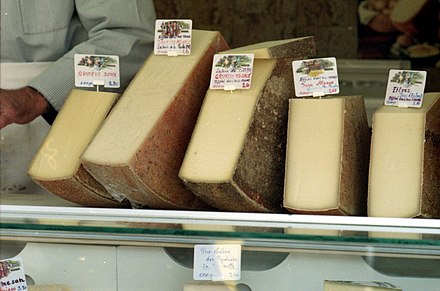List of Swiss cheeses

This is a list of the varieties of traditional cheeses made in Switzerland. Switzerland produces over 475 varieties of cheese, a milk-based food produced in a large range of flavors, textures, and forms.[1][2] Cow's milk is used in about 99 percent of the cheeses Switzerland produces. The remaining share is made up of sheep milk and goat milk. The export of these cheeses, some 40% of production in 2019, is economically important for Switzerland.[3]
The best known Swiss cheeses are of the class known as Swiss-type cheeses, also known as Alpine cheeses, a group of hard or semi-hard cheeses with a distinct character, whose origins lie in the Alps of Europe, although they are now eaten and imitated in most cheesemaking parts of the world. These include Emmental, Gruyère and Appenzeller, as well as many other traditional varieties from Switzerland and neighbouring countries with Alpine regions. Their distinct character arose from the requirements of cheese made in the summer on high Alpine grasslands (alpage in French), and then transported with the cows down to the valleys in the winter, in the historic culture of Alpine transhumance. Traditionally the cheeses were made in large rounds or "wheels" with a hard rind, to provide longevity to the shelf-life.[4]

Technically Swiss-type cheeses are "cooked", meaning made using thermophilic lactic fermentation starters, incubating the curd with a period at a high temperature of 45°C or more.[5] Since they are later pressed to expel excess moisture, the group are also described as "'cooked pressed cheeses'",[6] fromages à pâte pressée cuite in French. Most varieties have few if any holes, or holes that are much smaller than the large holes found in some Emmental or its imitations. The general eating characteristics of the cheeses are a firm but still elastic texture, flavour that is not sharp, acidic or salty, but rather nutty and buttery. When melted, which they often are in cooking, they are "gooey", and "slick, stretchy and runny".[7]

Varieties
Extra-hard

- Sbrinz AOP
- Berner Hobelkäse (AOP) [8]
Hard
- Appenzeller
- Berner Alpkäse (AOP)
- Bündner Bergkäse
- Gruyère/Greyerzer (AOP)
- L'Etivaz (AOP)
- Röthenbacher Bergkäse[9]
- Mutschli
- Schabziger
- Tête de Moine (AOP)
Semi-hard

- Emmentaler (AOP)
- Raclette du Valais (AOP)
- Scharfe Maxx
- Le Marechal
- Tilsiter
- Vacherin Fribourgeois (AOP)
Semi-soft
- Formaggini
- Luzerner Rahmkäse
Soft
- Vacherin Mont d'Or (AOP)
- Gala
- Büsciun da cavra
- Tomme Vaudoise
Fresh
Blue
See also
Notes
- ^ Dominik Sauerländer, Anne-Marie Dubler: Käse in German, French and Italian in the online Historical Dictionary of Switzerland, 5 February 2018.
- ^ DK Eyewitness Travel Guide Switzerland. Travel Guide. DK Publishing. 2017. p. 261. ISBN 978-1-4654-6725-6. Retrieved 28 December 2019.
- ^ "2019: a good year for Swiss cheese exports"
- ^ Donnelley, 3-5; Thorpe, 262-268; Oxford, 15-19
- ^ Lortal, 291-292
- ^ Thorpe, 266
- ^ Thorpe, 266-267; Donnelley, 3-5
- ^ "Berner Alp- und Hobelkäse - Cheeses from Switzerland - Switzerland Cheese Marketing". www.cheesesfromswitzerland.com. Retrieved 8 April 2018.
- ^ "Käserei Rüegsegg". www.regionalprodukte.ch. Archived from the original on 2020-06-04. Retrieved 2020-06-04.
References
- Donnelley, Catherine W. (ed), Cheese and Microbes, 2014, ASM Press, ISBN 1555818595, 9781555818593, google books
- Lortal, Sylvie, "Cheeses made with Thermophilic Lactic Starters", Chapter 16 in Handbook of Food and Beverage Fermentation Technology, 2004, CRC Press, ISBN 0203913558, 9780203913550, google books
- "Oxford": Donnelley, Catherine W. (ed), The Oxford Companion to Cheese, 2016, Oxford University Press, ISBN 0199330883, 9780199330881, google books
- Thorpe, Liz, The Book of Cheese: The Essential Guide to Discovering Cheeses You'll Love, 2017, Flatiron Books, ISBN 1250063469, 9781250063465, google books
External links
- Cheeses from Switzerland, Switzerland Cheese Marketing